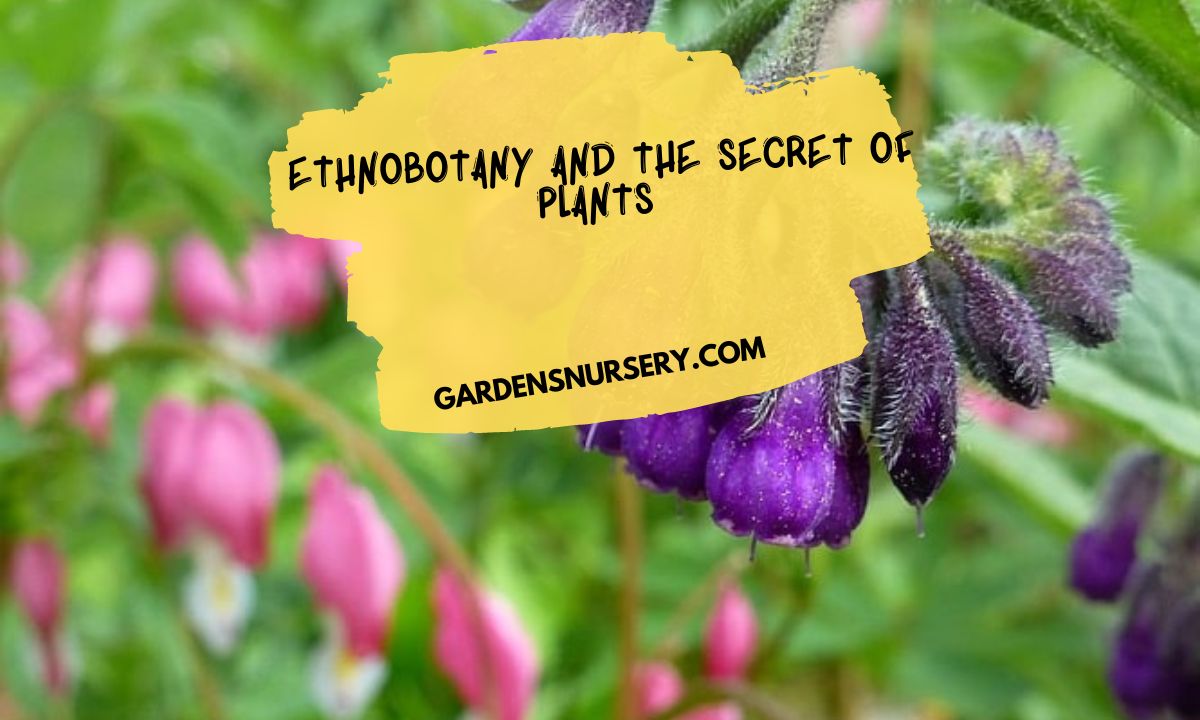
Ethnobotany, the study of the relationship between people and plants, has been a fascinating field of research for centuries. Throughout history, indigenous cultures and traditional societies have relied on their deep knowledge of plants and their medicinal properties for healing and wellness.
The secret of plants, hidden in their unique chemical compositions and medicinal properties, has been passed down through generations, contributing to the development of modern medicine and our understanding of the natural world. In this article, we will explore the intriguing world of ethnobotany and delve into the secrets of plants that have captivated the curiosity of scientists, researchers, and plant enthusiasts alike.
Ethnobotany or Ethnobotanical gardens include plants that maintain (or have maintained) with the mana report of use, in its geographical context and through its very complex history. They were revisited by a mixed team of gardeners, mediators, perfume technicians, plant protectionists, and ethnobotanists, to propose to the public CJBG a permanent space for scenography with renewed scientific content.
These ethnobotanical gardens make up several terraced garden areas, grouped into four categories of use, for four label colors different and arranged on two landscape axes.
1. The Garden of Foods (condiments, wild picking, unknown vegetables, nutraceuticals)
2. The medicinal garden (classified by application organs active ingredients)
3. The economic garden (perfumes, sugars, dyes, oils, resins, and fibers)
The Botanical Utilities Garden (plants) spiritual, toxic, vine and wheat, organic garden, weaving, and regional woods) More than 500 species are presented and challenge us over 550 m2, as to the ratio we maintain daily with the plant world.
This usage relationship has fluctuated throughout our history, at will:
• Periods of famine (war, disaster, famine) that revive the direct recourse to the world wild plant and new introductions plants (for example the potato of South American origin replaced, in our plates, more than 20 species of edible roots belonging to our flora)
• Discoveries, especially technological ones, that have supplanted many uses Phyto-artisanal (basketry, uses of wood, laundry and household disinfectants, cosmetics, etc.)
• Anthropogenic selections (crosses, genome manipulations, etc.)
If the natural biodiversity suffered during the twentieth century unparalleled attacks in the history of humanity, it was the same for cultural diversity related to the use of plant species.
In these gardens, each plant is labeled specifically with complete information. of the showcases stick to the “table” panels largely illustrated. Quiz travel, an English version of the permanent presentation and a database audiovisual thematic, accessible by QR codes, allows interested visitors to deepen their knowledge. This thematic bibliography comes advantageously to complete the whole.
Ethnobotany
The term “ethnobotany” was first coined in 1896 by the American botanist John Harshberger as the study of plants used by primitive and aboriginal people. Since then it has been defined as the traditional knowledge of indigenous communities of the surrounding plant diversity and the study of how the people of a particular culture and region make use of indigenous plants.
Ethnobotany has its roots in botany. Botany, in turn, originated in part from an interest in finding plants to help fight illness. Ethnobotany is the most important approach to study the natural resource management of indigenous people. The issues of economic compensation and protected areas raise the problem of the divergence between conservation managers and village communities in their perception, mode of presentation, and system of resource appropriation and allocation.
Conservation managers’ recognition of the knowledge and practices of indigenous people would help reduce tension and conflict between these two parties. Ethnobotany includes all types of relationships between people and plants.
The definition of ethnobotany can be summed up in four words: people, plants, interactions, and uses. “Ethnobotany is the study of how the people of a particular culture and region make use of indigenous garden plants,” while the ethnobotanist explores how plants are used as food, shelter, medicine, and clothing, for hunting, and in religious ceremonies. It is the science studying “the relationship between a given society and its environment and in particular the plant world”.
The Swede naturalist Carl Linnaeus invented ethnobotany as a student during his journey in 1732 to Lapland. On July 4, 1732, Linnaeus recorded in his diary some medical remedies used by the Sami people: “I here made the following observations relative to the remedies used by the Laplanders.
Their Moxa, as The Japanese call it, but which they term Toule, is made of a fine fungus found on the birch. They apply a piece as large as a pea upon the afflicted part”. He published the Flora lapponica in 1737, which included a discussion of how specific plants were utilized by the Laplander (Sami) people. Harshberger’s definition and vision from 1896 still provide the core for the science of ethnobotany.
A slight change in emphasis can be seen through a review of Cotton’s current definition: “Ethnobotany is considered to encompass all studies which concern the mutual relationship between plants and traditional peoples”. The early definitions of ethnobotany restricted the field to the study of how aboriginal people used plants. Botanists, explorers, and other people who traveled the globe would see a plant and then identify, classify, and name it for science.
They would ask a resident to give the name of the plant in the local language or to specify the local uses of the plant. This resulted in numerous monographs on the cultural group uses of plants. The particular focus of such monographs would vary depending upon the specific interest of the person undertaking the study.
These early attempts of ethnobotany are considered the articulation of colonial economies, imaginations, and projects. They can also be seen as the basic data-gathering stage of the ethnobotanical discipline. At present, ethnobotany has shifted its focus from people’s use of plants to the relationship between people and plants, which includes the use, cognition, and ecology.
Recent Ethnobotany Definitions
Recent definitions of Ethnobotany demonstrate a consensus on the move to include more than just use by focusing on the relationship between people and plants. However, there is not consensus on whether the discipline should focus on all people or traditional and indigenous peoples. People who have lived in one locality for a long time have particularly rich sets of knowledge about and cognition of plants and local ecology. A more fundamental issue relative to knowledge, however, is found within the discussion of the relationship between knowledge as practice and knowledge as heritage.
Ethnobotany has its roots in botany, the study of plants. Botany, in turn, originated in part from an interest in finding plants to help fight illness. Medicine and botany have always had close ties. Many of today’s drugs have been derived from plant sources. However, as modern medicine and drug research advanced, chemically synthesized drugs replaced plants as the source of most medicinal agents in industrialized countries.
Although research in plant sources has continued and plants are still used as the basis for drug development, the dominant interest and resulting research funding have shifted to the laboratory.
Unveiling the Medicinal Potential of Plants
Modern Ethnobotanical Research With the advancement of modern science, ethnobotany has gained renewed interest and has become a field of research that combines traditional knowledge with modern scientific methods to unlock the medicinal potential of plants. Today, ethnobotanists conduct rigorous scientific studies to identify and understand the active compounds present in plants and their potential therapeutic uses.
One such example is the discovery of the anti-cancer properties of the Pacific yew tree (Taxus brevifolia), a coniferous tree found in North America. The bark of the Pacific yew tree was traditionally used by Native American tribes for various medicinal purposes, but it was only through scientific research that it was found to contain a compound called Taxol, which has been proven to be effective in treating certain types of cancer.
The Role of Ethnobotany in Conservation and Sustainable Resource Management
Ethnobotany not only unravels the secrets of plants but also plays a crucial role in conservation and sustainable resource management. Many traditional practices of using plants for food, medicine, and other purposes are based on sustainable harvesting techniques that have been passed down through generations.
In recent years, there has been a growing recognition of the importance of traditional knowledge in preserving biodiversity and promoting sustainable resource management. For example, the traditional practice of shifting agriculture, commonly known as “swidden agriculture,” practiced by many indigenous tribes, involves rotating cultivation and fallow periods to allow the land to regenerate naturally. This practice helps to maintain the balance of the ecosystem and ensures the sustainability of resources for future generations.
Traditional Plant-Based Medicine
Traditional plant-based medicine has been a significant aspect of ethnobotanical practices for centuries. Many indigenous cultures have developed sophisticated systems of plant-based medicine, using herbs, roots, bark, and other plant parts to treat a wide range of illnesses and conditions. Traditional Chinese Medicine (TCM), for example, has a history of over 5,000 years and relies heavily on the use of plant-based remedies, such as ginseng, astragalus, and licorice, to restore balance and promote health. Similarly, Ayurvedic medicine, a traditional Indian system of medicine, utilizes a vast array of plant-based remedies, including turmeric, neem, and ashwagandha, to treat various ailments and improve well-being.
Traditional plant-based medicine underscores the importance of understanding the unique chemical compositions of plants and their medicinal properties. Many plants contain bioactive compounds, such as alkaloids, flavonoids, and terpenes, that possess potent medicinal properties. For example, the bark of the cinchona tree, native to South America, contains quinine, a powerful antimalarial compound that has saved countless lives. The traditional use of plants for medicinal purposes has provided a rich repository of knowledge that has guided modern research in the field of ethnobotany.
The Secret Uses of the Plants
The document of the secret uses of the plants, ethnobotany has become an important part of our world. Recent ethnobotanical surveys among tribal populations have brought new information to the forefront, which can be utilized to improve the economy of the tribes by organizing the systematic collection of forest products and locating cottage industries, especially of herbal drugs. In China, ethnobotany was introduced as a science in the late 1970s, but deep-rooted ethnobotanical knowledge in Chinese culture can be traced back to ancient times in Chinese history.
This is evidenced by the vast literature on Chinese Materia Medica and Chinese works of agriculture and horticulture. In India and Pakistan, three traditional systems of medicine, namely, Ayurveda, Siddha, and Unani, are distinguished. Ethnomedicine is an area of research that deals with medicines derived from plants, animals, or minerals and used in the treatment of various diseases and ailments based on indigenous pharmacopeia, folklore, and herbal charm.
Ethnobotany has an important role in the conservation of nature, culture, and, in particular, the biological diversity and the diversity of traditional human cultures in the world. Conservation and biodiversity are linked to each other.
Medicinal Uses of Plants
Traditional knowledge systems are hundreds or even thousands of years old and involve not only the knowledge of plants for medicine and food but also strategies for the sustainable utilization of plant resources. In these respects, ethnobotany has played a vital role in describing traditional knowledge about the medicinal uses of plants and will continue to do so in the future. To discover the practical potential of native plants, an ethnobotanist must be knowledgeable in the study of plants themselves and must also understand and be sensitive to the dynamics of how cultures work.
Ethnobotanists have helped us to understand the frightening implications the loss of the rain forests would bring, not only the consequently lost knowledge about tropical plants but also the damage brought about by the loss of native cultures in their entirety, as well as the damage to the Earth’s ecological health. Out of necessity, ethnobotany is a multidisciplinary science.
This multidisciplinary approach gives ethnobotanists more insight into the management of forest reserves in a period of tremendous environmental stress. Unfortunately, due to human factors that have influenced the ecological balance of these delicate ecosystems, we are presently faced with the possibility of losing our forests. Ethnobotany is an emerging science that has a vital role in the improvement of plants and plant products. It certainly adds to conservation and can also be utilized for value addition.
The two fundamental strengths of applied ethnobotany are To allow the knowledge, wisdom, and practices of local people to play fuller roles in identifying and finding solutions to issues of conservation and sustainable development.
for more information see this video:










Ηelⅼo, constantly i used to check website posts here early іn the daylight, since i love to ɡain knowledge of more and more.